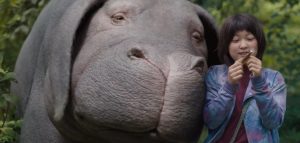 In a key scene in the film Okja, we see a young girl named Mija walking with her genetically-engineered superpig friend, Okja, as tens of thousands of nameless beasts watch through a feedlot fence. Director Bong Joon-ho is asking viewers to reflect on what separates Okja from her fellow species and whether the distinction is significant. Okja is the tale of a relationship between a young girl and an animal, but it is also an exploration of capitalist food production, genetically modified organisms, and animal rights. The divide the film explores, between the animals with which we develop bonds of affection and those we butcher and eat has not always existed, and it both enables industrial animal husbandry, and constitutes one of its critical weaknesses.
In a key scene in the film Okja, we see a young girl named Mija walking with her genetically-engineered superpig friend, Okja, as tens of thousands of nameless beasts watch through a feedlot fence. Director Bong Joon-ho is asking viewers to reflect on what separates Okja from her fellow species and whether the distinction is significant. Okja is the tale of a relationship between a young girl and an animal, but it is also an exploration of capitalist food production, genetically modified organisms, and animal rights. The divide the film explores, between the animals with which we develop bonds of affection and those we butcher and eat has not always existed, and it both enables industrial animal husbandry, and constitutes one of its critical weaknesses.
People today largely categorize domesticated animals into two groups, those that are individuated and with personality, i.e. our pets, and those that only exist as part of an undifferentiated mass that we eat or turn into coats. This distinction is not merely about feelings. It has real world implications. Pets are protected by cruelty laws; livestock are not. Often, but not always, this line is divided by species: cats are pets, turkeys are food. The systems of modern animal husbandry are designed to police this boundary. Few consumers could have any direct familiarity with the animals that become their food even they wanted to and video-recording slaughterhouses is illegal in many places. Slaughterhouse workers—themselves thought of in similarly abstract and faceless terms—do the actual killing. These boundaries absolve us of responsibility for the treatment of the animals we eat. The fact that we love Fluffy makes it easier to draw a circle around animals with which we don’t develop affective relationships.
Though this divide largely promotes indifference to the well-being of livestock, Okja reveals how our love for individual animals can mobilize opposition to industrial animal husbandry. In the film, the Animal Liberation Front (ALF) fights the attempt to popularize the superpig as the meat of the future. When they distribute undercover footage of the abuse of the superpigs in a secret laboratory, they rely on the affective connection people feel when confronted with the suffering of a fellow mammal. Though we are meant to sympathize with the ALF’s goals, the characters do not escape the director’s satire; one character is perpetually woozy from his reluctance to eat almost anything and Paul Dano plays a surprisingly violent animal defender.
On the whole, the movie plays on the sense of empathy and collective outrage people today feel when actually confronted with the workings of industrial husbandry on individual animal bodies. However, for both the film and the ALF characters in it, this approach put critics of animal husbandry in a bind. Connection with individual animals builds empathy and support for reform, but without requiring popular commitment to clear plans for change. It puts the focus on individuals and relationships, when the problems of animal husbandry are about the broader social and economic system—the forces that create the pen filled with thousands of nameless creatures.
Of course the idea that caring about an animal and eating it are necessarily at odds is not a universal assumption, but one borne of the increasing separation (physically and conceptually) between us and the production of our food. The movie hints at this reality through Mija’s grandfather, who cares for and about Okja, but also sends her off to be slaughtered. He soon reacts with surprise at the intensity of his grand-daughter’s outrage. Though we might similarly condemn his decision, his response suggests working with or even eating animals does not preclude caring about them. This tell us that there might be ways to promote animal husbandry reform without relying on the pet/livestock paradigm that dominates popular opinion today.
As Mija and Okja flee the feedlot to which Okja was sent, two animals from the doomed herd engineer the escape of a piglet—presumably their child. Our protagonists take it back home and it is later frolicking in a lush forest. In the end, the special bond between Mija and Okja survives, and they seem (mostly) untroubled by the fact that consumers worldwide are munching on superpig jerky. The film is not entirely clear whether this absolves us from, or implicates us in, the fate of the remaining animals to which we do not give names.
tl;dr review of the film: mostly only okay, the ending is pretty good. Punctuated with some quality superpig toilet humor, it’s one of those movies that, to paraphrase Levi-Strauss, is good to stink with.